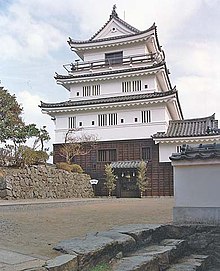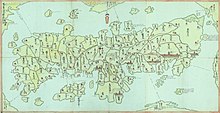Hirado Domain (平戸藩), also known as Hirado-han, was a domain during the Edo period in Japan. It was located in Hizen Province, which is now part of Nagasaki Prefecture. The han system in Hirado was a political and economic concept that relied on surveys and projected agricultural yields, rather than land area, to define the domain. This system was distinct from the feudalism of the Western world. [1] [2] [3]
| Hirado Domain 平戸藩 | |
|---|---|
| Domain of Japan | |
| 1600–1871 | |
 A 16th-century French depiction of
Hirado Castle | |
Mon of the
Matsura clan
| |
 Keep of Hirado Castle | |
| Capital | Hirado Castle |
| Government | |
| • Type | Daimyō |
| Daimyō | |
• 1587-1600 | Matsura Shigenobu (first) |
• 1858-1871 | Matsura Akira (last) |
| Historical era | Edo period Meiji period |
• Established | 1600 |
• Disestablished | 1871 |
| Today part of | Nagasaki Prefecture |


History
Following the successful conquest of Kyushu by Toyotomi Hideyoshi, Matsura Shigenobu, a local warlord, was granted control over Hirado County, Iki Island and Hario Island. During the Japanese invasions of Korea, Hirado served as a strategic base for Japanese forces. In 1599, Matsura Shigenobu built Hinotake-jō Castle on the site where Hirado Castle stands today. However, he later burned down the castle in 1613 as a display of loyalty to Shōgun Tokugawa Ieyasu, despite having fought on the losing side during the Battle of Sekigahara. In return for his loyalty, he was allowed to retain his position as the daimyō of Hirado Domain under the Tokugawa bakufu. The present-day Hirado Castle was constructed in 1704 under the orders of Matsura Takashi, the 5th daimyō of Hirado domain. This castle played a crucial role in Japan's seaward defenses in the East China Sea region, as the country had implemented a policy of national seclusion against Western traders and missionaries. Matsura Takashi also established a subsidiary domain, Hiradoshinden Domain, for his younger brother, Matsura Masashi. Despite his important positions in the Tokugawa Shogunate, Matsura Takashi's expenses in rebuilding Hirado Castle nearly bankrupted the domain. Matsura Kiyoshi, the 9th daimyō, was a renowned writer of essays and a respected political analyst. On the other hand, Matsura Akira, the last daimyō, led his troops as a member of the Satchō Alliance during the Boshin War of the Meiji Restoration, fighting in favor of Emperor Meiji. He participated in significant battles such as the Battle of Toba–Fushimi and engaged the Tokugawa loyalists of the Ōuetsu Reppan Dōmei in the northern regions of Japan, specifically at Morioka and Akita. In April 1884, he was granted the title of count within the newly established kazoku peerage system. Following this, starting from 1890, he held a position in the House of Peers of the Diet of Japan. Eventually, he was honored with the 2nd Court rank.
Hiradoshinden Domain
Hiradoshinden Domain (平戸新田藩) serves as a satellite domain under the jurisdiction of Hirado Domain and is also known as Hirado Tateyama Domain. The domain operated a jinya in Tateyama, located in Hirado City, Nagasaki Prefecture, serving as the administrative center. In 1689, Masaru, the younger brother of the fifth lord of Hirado Domain, Mune, was granted 10,000 koku of land, leading to the establishment of Hirado Nitta domain. However, in 1870, it was absorbed back into the main domain and subsequently dissolved. By 1884, Masaru was ennobled as a viscount for his services. Additionally, within the Tokugawa clan's residence, one of the renowned "Seven Wonders of Honjo" was the "Shii without Fallen Leaves," situated in the upper mansion. This mysterious phenomenon added to the allure and intrigue surrounding the historical significance of the Edo clan's estate, further solidifying its place in local folklore and legend.
Holdings at the end of the Edo period
It also includes the territory of the Hirado Shinden Domain which was incorporated in 1870.
- Hizen Province :
- Matsuura County : 47 villages
- Sonogi County : 7 villages
- Iki Province :
- Iki County : 11 villages
- Ishida County : 11 villages
List of daimyōs
Name Tenure Courtesy title Court Rank Revenue  Matsura clan, 1587 - 1871 (
Tozama daimyo)
Matsura clan, 1587 - 1871 (
Tozama daimyo)
1 Matsura Shigenobu (松浦鎮信) 1587 – 1600 Hizen-no-kami Junior 4th Rank Lower Grade (従四位下) 63,200 koku 2 Matsura Hisanobu (松浦久信) 1600 – 1602 Hizen-no-kami Junior 5th Rank Lower Grade (従四位下) 63,200 koku 3 Matsura Takanobu (松浦隆信) 1603 –1637 Hizen-no-kami Junior 5th Rank Lower Grade (従四位下) 63,200 koku 4 Matsura Shigenobu (松浦鎮信) 1637 – 1689 Hizen-no-kami Junior 5th Rank Lower Grade (従四位下) 61,700 koku 5 Matsura Takashi (松浦棟) 1689 – 1713 Hizen-no-kami, Jisha-bugyō Junior 5th Rank Lower Grade (従四位下) 51,700 koku 6 Matsura Atsunobu (松浦篤信) 1713 – 1727 Hizen-no-kami Junior 5th Rank Lower Grade (従四位下) 61,700 koku 7 Matsura Arinobu (松浦有信) 1727 – 1728 Hizen-no-kami Junior 5th Rank Lower Grade (従四位下) 61,700 koku 8 Matsura Sanenobu (松浦誠信) 1728 – 1775 Hizen-no-kami Junior 5th Rank Lower Grade (従四位下) 61,700 koku 9 Matsura Kiyoshi (松浦清) 1775 – 1806 Iki-no-kami Junior 5th Rank Lower Grade (従四位下) 61,700 koku 10 Matsura Hiromu (松浦熈) 1806 - 1841 Hizen-no-kami Junior 5th Rank Lower Grade (従四位下) 61,700 koku 11 Matsura Terasu (松浦曜) 1841 – 1858 Iki-no-kami Junior 5th Rank Lower Grade (従四位下) 61,700 koku 12 Matsura Akira (松浦詮) 1858 – 1871 Hizen-no-kami Junior 2th Rank Lower Grade (従四位下) 61,700 koku

- Hiradoshinden Domain
# Name Tenure Courtesy title Court Rank kokudaka  Matsura clan, 1689 - 1870 (
fudai daimyo)
Matsura clan, 1689 - 1870 (
fudai daimyo)
1 Matsuura Masashi (松浦昌) 1689 - 1706 Bungo no kami (文語 の 髪) Junior 5th Rank Lower Grade (従四位下) 3,000 koku 2 Matsuura Satoshi (松浦聡) 1706 - 1708 Bungo no kami (文語 の 髪) Junior 5th Rank Lower Grade (従四位下) 3,000 koku 3 Matsuura Chikashi (松浦知) 1708 - 1728 Bungo no kami (文語 の 髪) Junior 5th Rank Lower Grade (従四位下) 3,000 koku 4 Matsuura Mitsuru (松浦致) 1728 - 1766 Yamato no kami (大和守) Junior 5th Rank Lower Grade (従四位下) 3,000 koku 5 Matsuura Takara (松浦宝) 1766 - 1783 Yamato no kami (大和守) Junior 5th Rank Lower Grade (従四位下) 3,000 koku 6 Matsuura Norihiro (松浦矩) 1783 - 1803 Yamato no kami (大和守) Junior 5th Rank Lower Grade (従四位下) 3,000 koku 7 Matsuura Chikashi (松浦良) 1803 - 1814 None Junior 5th Rank Lower Grade (従四位下) 3,000 koku 8 Matsuura Hikaru (松浦 晧) 1814 - 1850 Yamato no kami, Bingo no kami, Iyo no kami (やまとの髪、 便ごの髪、 伊予の髪) Junior 5th Rank Lower Grade (従四位下) 3,000 koku 9 Matsuura Nagashi (松浦脩) 1850 - 1870 Hizen no kami (肥前守) Junior 5th Rank Lower Grade (従四位下) 3,000 koku
See also
References

- ^ Shinjinjin, Oraisha (1997). 別冊歴史読本24 江戸三百藩 藩主総覧 歴代藩主でたどる藩政史. Shinjinjin Oraisha. ISBN 978-4404025241. (In Japanese).
- ^ Shigeo, Nakajima (2003). 大名の日本地図. Bunshun Shinsho. ISBN 978-4166603527. (In Japanese).
- ^ Noell Wilson (2020), Defensive Positions. The Politics of Maritime Security in Tokugawa Japan. Google Book. ISBN 9781684175567
